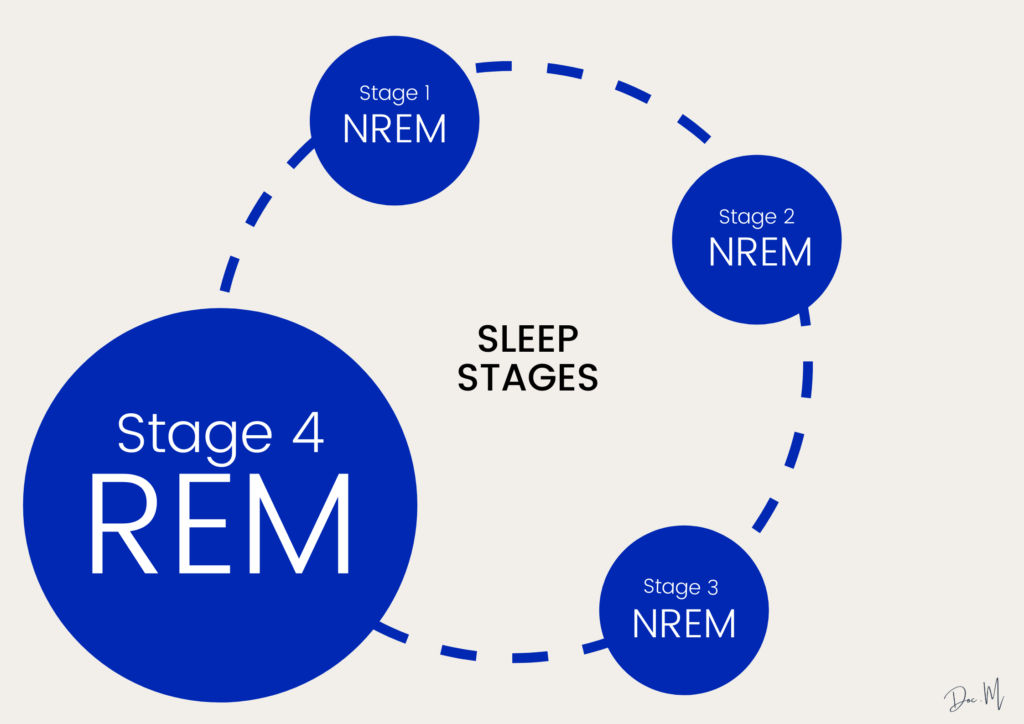Although we experience sleep as one event, it actually happens in stages. When we sleep, our body goes through different stages. These stages are what we call the “stages of sleep” or “the sleep cycle”. The sleep cycle has four stages; three stages of Non-Rapid Eye Movement (NREM sleep) and one stage of Rapid Eye Movement (REM sleep). These stages continue to go on in loops throughout the night.

Rapid eye movement (REM) sleep is the fourth stage in our sleep cycle. Before the REM stage, our body goes through the three NREM stages (N1, N2, and N3). Our bodies calm down during these stages. Breathing slows down, muscles relax, heart rate goes down, body temperature decreases, and brain activity slows down. And once our body reaches N4 (REM), we enter the deepest and the most active phase of our sleep cycle.
It takes us approximately 90-100 minutes post-falling asleep to enter the N4 stage.
Also Read: Personalization Of Well-Being In A Tech-Driven World
Since babies sleep most of the day, they spend about eight hours in the REM stage. However, in adulthood, this number comes down and N4 only accounts for about 20-25% of our total sleep time.
During N4 our brain activity goes up to almost the same levels as when we are awake. Brainwaves go up and down in amplitude, similar to patterns seen during the state of wakefulness. While brain activity goes up, the body enters a complete paralysis-like state, called REM-Atonia. This is because the motor neurons become inhibited. REM-Atonia does not affect two muscles though (eyes muscles and the muscles that control breathing). The stage is called “rapid eye movement” because the eyes can be seen moving rapidly even though the eyelids remain shut.
Phasic & Tonic Patterns of N4:
Let’s look into the two types of patterns of N4: phasic and tonic, to better understand what goes on in our body during REM sleep.
Tonic REM patterned sleep is persistent through the N4 phase. The Phasic pattern is overlapping and continuous. Tonic REM is also characteristic of bursts of activity and muscle twitches.
Tonic REM consists of longer and more inactive phases, in between periods of phasic activity. While blood pressure goes up during REM sleep as compared to NREM, it particularly happens during phasic REM. Additionally, during phasic REM, sudden bursts of activity in the nerves that supply the skin or muscle blood vessels are detectable. These increased activities are what result in abrupt spikes in blood pressure during N4.
Biological Functions During REM:
Heart rate becomes inconsistent during this phase sleep. It becomes faster during phasic REM as compared to tonic REM and is consistent with sympathetic activation. The rapid fluctuations in blood pressure, autonomic activity, and heart rate during REM, are considered to be possible triggers for adverse cardiovascular events. These have also been associated with chest pain during nights.
REM sleep is also believed to play an active part in the consolidation of memories. REM sleep benefits our learning, memory, and mood. It also contributes to brain development in children. Lack of REM sleep has also been linked to having adverse implications on our emotional and physical health. Multiple studies have also linked it to problems in relationships, with trends indicating increased marital conflicts.
Here’s what the studies say:
Studies show, that when individuals failed to enter the REM stage, they had difficulty recalling what they were taught prior to dozing off. In a study on rats that were deprived of REM sleep, negative effects were seen on cell proliferation in the brain, particularly in the area responsible for long-term memory.
It is believed that REM sleep plays a crucial role in the brain development of infants. Some studies suggest that it is responsible for the necessary neural stimulation required to develop mature neural connections. This is a possible explanation for why babies require substantially more REM as compared to adults. Infact, babies only have 2 stages in their sleep cycle till they are 4 months old. They spend half of their sleep is in the REM stage and the other half in NREM till then. It’s only by the age of 5 years, that children develop sleep cycles that mirror those of adults.
REM sleep is fascinating, paradoxical, and necessary.
Here’s a BioHack you can use to get sufficient REM sleep: establish a sleep schedule and stick to it.
Happy & Healthy BioHacking to you!